Analysis and visualization of disease courses in a semantically-enabled cancer registry
- PMID: 28962670
- PMCID: PMC5622544
- DOI: 10.1186/s13326-017-0154-9
Analysis and visualization of disease courses in a semantically-enabled cancer registry
Abstract
Background: Regional and epidemiological cancer registries are important for cancer research and the quality management of cancer treatment. Many technological solutions are available to collect and analyse data for cancer registries nowadays. However, the lack of a well-defined common semantic model is a problem when user-defined analyses and data linking to external resources are required. The objectives of this study are: (1) design of a semantic model for local cancer registries; (2) development of a semantically-enabled cancer registry based on this model; and (3) semantic exploitation of the cancer registry for analysing and visualising disease courses.
Results: Our proposal is based on our previous results and experience working with semantic technologies. Data stored in a cancer registry database were transformed into RDF employing a process driven by OWL ontologies. The semantic representation of the data was then processed to extract semantic patient profiles, which were exploited by means of SPARQL queries to identify groups of similar patients and to analyse the disease timelines of patients. Based on the requirements analysis, we have produced a draft of an ontology that models the semantics of a local cancer registry in a pragmatic extensible way. We have implemented a Semantic Web platform that allows transforming and storing data from cancer registries in RDF. This platform also permits users to formulate incremental user-defined queries through a graphical user interface. The query results can be displayed in several customisable ways. The complex disease timelines of individual patients can be clearly represented. Different events, e.g. different therapies and disease courses, are presented according to their temporal and causal relations.
Conclusion: The presented platform is an example of the parallel development of ontologies and applications that take advantage of semantic web technologies in the medical field. The semantic structure of the representation renders it easy to analyse key figures of the patients and their evolution at different granularity levels.
Keywords: Biomedical informatics; Cancer registry; Ontology; Semantic web.
Conflict of interest statement
Ethics approval and consent to participate
Not applicable.
Consent for publication
Not applicable.
Competing interests
The authors declare that they have no competing interests.
Publisher’s Note
Springer Nature remains neutral with regard to jurisdictional claims in published maps and institutional affiliations.
Figures
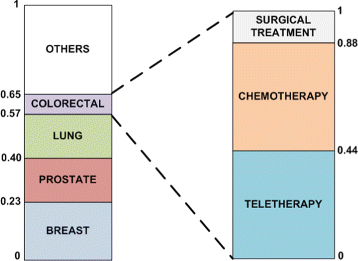
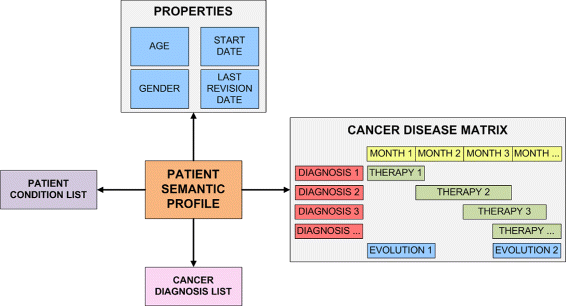
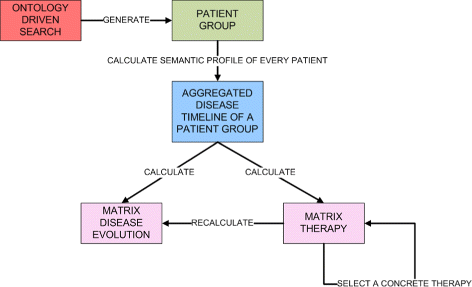
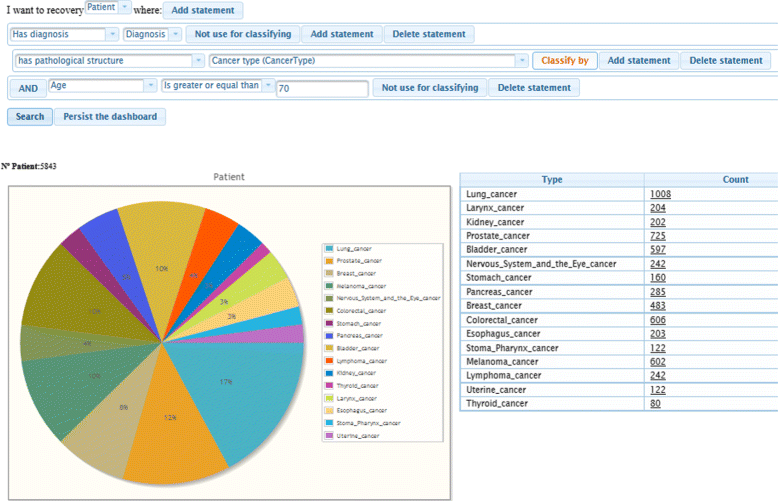
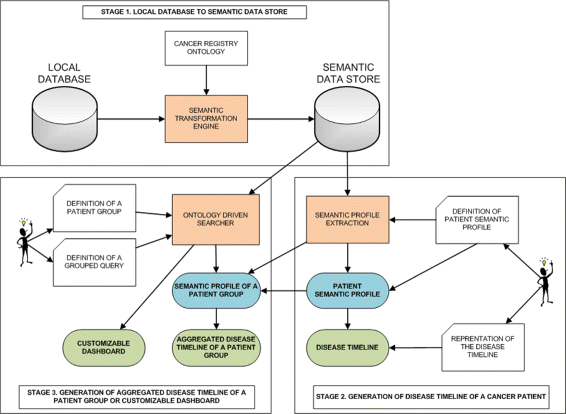
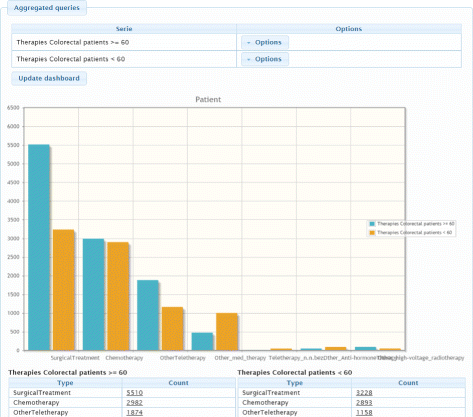
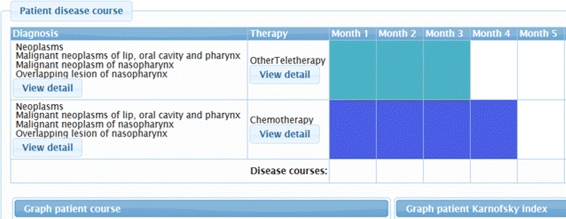


Similar articles
-
Semantic integration of information about orthologs and diseases: the OGO system.J Biomed Inform. 2011 Dec;44(6):1020-31. doi: 10.1016/j.jbi.2011.08.002. Epub 2011 Aug 16. J Biomed Inform. 2011. PMID: 21864715
-
AlzPharm: integration of neurodegeneration data using RDF.BMC Bioinformatics. 2007 May 9;8 Suppl 3(Suppl 3):S4. doi: 10.1186/1471-2105-8-S3-S4. BMC Bioinformatics. 2007. PMID: 17493287 Free PMC article.
-
Semantic web for integrated network analysis in biomedicine.Brief Bioinform. 2009 Mar;10(2):177-92. doi: 10.1093/bib/bbp002. Brief Bioinform. 2009. PMID: 19304873
-
Towards Semantic e-Science for Traditional Chinese Medicine.BMC Bioinformatics. 2007 May 9;8 Suppl 3(Suppl 3):S6. doi: 10.1186/1471-2105-8-S3-S6. BMC Bioinformatics. 2007. PMID: 17493289 Free PMC article. Review.
-
DOORS to the semantic web and grid with a PORTAL for biomedical computing.IEEE Trans Inf Technol Biomed. 2008 Mar;12(2):191-204. doi: 10.1109/TITB.2007.905861. IEEE Trans Inf Technol Biomed. 2008. PMID: 18348949 Review.
Cited by
-
Knowledge Graph-Enabled Cancer Data Analytics.IEEE J Biomed Health Inform. 2020 Jul;24(7):1952-1967. doi: 10.1109/JBHI.2020.2990797. Epub 2020 May 4. IEEE J Biomed Health Inform. 2020. PMID: 32386166 Free PMC article.
-
Ontologies and Knowledge Graphs in Oncology Research.Cancers (Basel). 2022 Apr 10;14(8):1906. doi: 10.3390/cancers14081906. Cancers (Basel). 2022. PMID: 35454813 Free PMC article. Review.
-
Operational tolerance research in liver transplantation: a bibliometric analysis using a new web resource.Front Res Metr Anal. 2024 Mar 14;9:1368534. doi: 10.3389/frma.2024.1368534. eCollection 2024. Front Res Metr Anal. 2024. PMID: 38550796 Free PMC article.
-
An ontology-based approach for developing a harmonised data-validation tool for European cancer registration.J Biomed Semantics. 2021 Jan 6;12(1):1. doi: 10.1186/s13326-020-00233-x. J Biomed Semantics. 2021. PMID: 33407816 Free PMC article.
-
As Ontologies Reach Maturity, Artificial Intelligence Starts Being Fully Efficient: Findings from the Section on Knowledge Representation and Management for the Yearbook 2018.Yearb Med Inform. 2018 Aug;27(1):140-145. doi: 10.1055/s-0038-1667078. Epub 2018 Aug 29. Yearb Med Inform. 2018. PMID: 30157517 Free PMC article. Review.
References
-
- Muir CS, Nectoux J. Role of the cancer registry. Natl Cancer Inst Monogr. 1977;47:3–6. - PubMed
-
- Jensen O, Whelan S, Jensen O, Parkin D, MacLennan R, Muir C, Skeet R. Planning a cancer registry. Cancer Registration: Principles and Methods. Lyon: International Agency for Research on Cancer; 1991.
-
- De Angelis R, Francisci S, Baili P, Marchesi F, Roazzi P, Belot A, Crocetti E, Pury P, Knijn A, Coleman M, et al. The EUROCARE-4 database on cancer survival in Europe: data standardisation, quality control and methods of statistical analysis. Eur J Cancer. 2009;45(6):909–30. doi: 10.1016/j.ejca.2008.11.003. - DOI - PubMed
MeSH terms
LinkOut - more resources
Full Text Sources
Other Literature Sources

